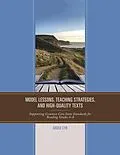This comprehensive manual that covers informational and literary texts will empower teachers to guide their students as they analyze challenging texts. Each lesson leads students to focus on the "why" and "how" of what an author is saying rather than just the "what." In addition to the detailed definitions and examples for dozens of literary techniques, Gisele Cyr includes teaching tips and talking points which will help teachers engage students in in-depth analyses of excerpts of classic, contemporary, and poetic works. With guided help, students will find the in-depth analyses enriching and foster an honest appreciation for the classics. The manual is designed to complement any school district's selections chosen to achieve mastery of the Common Core reading standards.
Autorentext
Gisele Cyr, MEd, is a public school teacher at Lewiston Middle School, in Maine, and has been teaching for 33 years.
Inhalt
Foreword
Common Core Standards Initiative: College and Career Readiness Anchor Standards for Reading
Part One: Facilitating Student Analyses of Literary Texts
Lesson 1: Internal and External Conflict
Lesson 2: Similes
Lesson 3: Metaphors
Lesson 4: Personification
Lesson 5: Symbolism
Lesson 6: Sensory Descriptors: Imagery and Onomatopoeia
Lesson 7: Rhyme: Rhyme Scheme, Alliteration and Assonance
Lesson 8: Allusions
Lesson 9: Diction and Dialect
Lesson 10: Inferences
Lesson 11: Irony
Lesson 12: Theme and Moral
Poetry
Lesson 13: Emily Dickinson, "Hope Is the Thing with Feathers"
Lesson 14: David, "Psalm 23,"The Bible
Lesson 15: Alan Cyr, "Childhood"
Lesson 16: Katherine Lee Bates, "America, the Beautiful"
Lesson 17: Paul Laurence Dunbar, "Sympathy"
Lesson 18: John McRae, "In Flanders Fields"
Lesson 19: Alfred Joyce Kilmer, "Trees"
Lesson 20: Emily Dickinson, "I Like To See It Lap the Miles"
Lesson 21: Emma Lazarus, "The New Colossus"
Lesson 22: William Shakespeare, "Sonnet 18"
Narrative Writing
Lesson 23: From J. M. Barrie, from Peter and Wendy
Lesson 24: Two Fables from Aesop
Lesson 25: Edward Connell "The Most Dangerous Game"
Lesson 26: O. Henry, "The Gift of the Magi"
Lesson 27: Jane Austin, from Sense and Sensibility
Lesson 28: Jules Verne, from Journey to the Center of the Earth
Lesson 29: Jack London, from White Fang
Drama
Lesson 30: Harriet Beecher Stowe, Uncle Tom's Cabin, (from Aiken Drama Version)
Part Two - Facilitating Student Analyses of Informational Texts
Text Structures
Lesson 31: Description
Lesson 32: Sequence/Chronological Order
Lesson 33: Problem and Solution
Lesson 34: Comparison and Contrast
Lesson 35: Cause and Effect
Lesson 36: Fact and Opinion/Editorials
Lesson 37: Propaganda Techniques
Integrating and Evaluating Content in Diverse Media and Formats
Lesson 38: Judging Bias in Diverse Media and Formats
Classics, Historical Documents and Primary Sources
Lesson 39: "The Preamble" to The Constitution of the United States
Lesson 40: "The Athenian Oath" and "The Pledge of Allegiance"
Lesson 41: from "The Fugitive Slave Act of 1850"
Lesson 42: Endnotes from Uncle Tom's Cabin by Harriet Beecher Stowe
Lesson 43: Civil War Journal Entry: "Letter from a Union Soldier"
Lesson 44: 1st Corinthians 13:1-7
Lesson 45: From "Meditation 17," by John Donne
Appendix A: Integrating and Evaluating Diverse Media
Teacher's Answer Key
